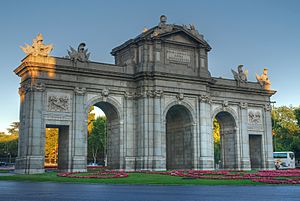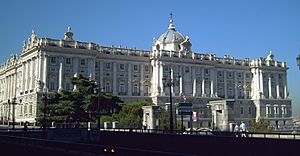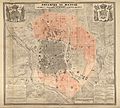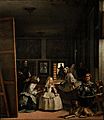Madrid facts for kids
Quick facts for kids
Madrid
|
|||
|---|---|---|---|
| [Villa de Madrid] Error: {{Lang}}: text has italic markup (help) | |||

From upper left: Puerta de Alcalá, Campo del Moro Gardens and Royal Palace, City Hall, Alcalá and Gran Vía street, Prado Museum, Statue of the Bear and the Strawberry tree (madroño) in Puerta del Sol Square, Cervantes Institute Foundation Headquarter, View of Royal Palace and Almudena Cathedral.
|
|||
|
|||
| Motto(s):
[«Fui sobre agua edificada,
mis muros de fuego son. Esta es mi insignia y blasón»] Error: {{Lang}}: text has italic markup (help) ("On water I was built, my walls are made of fire. This is my ensign and escutcheon") |
|||
| Country | Spain | ||
| Autonomous community |
Madrid | ||
| Founded | 9th century | ||
| Government | |||
| • Type | Mayor-council | ||
| • Body | Ayuntamiento de Madrid | ||
| Area | |||
| • City | 605.77 km2 (233.89 sq mi) | ||
| Elevation | 667 m (2,188 ft) | ||
| Population
(2011)
|
|||
| • City | 3,265,038 | ||
| • Rank | 1st | ||
| • Density | 5,390/km2 (14,000/sq mi) | ||
| • Urban | 6,087,000 | ||
| • Metro | 6,369,162 | ||
| Demonym(s) | Madrilenian, Madrilene [madrileño, -ña; matritense (es)] Error: {{Lang}}: text has italic markup (help) |
||
| Time zone | UTC+1 (CET) | ||
| • Summer (DST) | UTC+2 (CEST) | ||
| Postal code |
28001–28080
|
||
| Area code(s) | +34 (ES) + 91 (M) | ||
| Patron Saints | Isidore the Laborer Virgin of Almudena |
||
| Website | www.madrid.es | ||
Madrid (pronounced: “mah-DRID”) is the capital and largest city in Spain. It used to be Toledo until 1561.
Madrid is located in the middle of Spain. It is part of the Community of Madrid, a larger area that includes the city and nearby towns. Over 3 million people live in the city itself. It is the largest city in Spain.
At 655 meters (2,100 feet) above sea level, Madrid is the highest capital city in Europe. It is also the third largest city in the European Union. Madrid is home to two famous football teams: Real Madrid and Atlético Madrid.
Madrid has a long history. The Romans ruled it from the 2nd century. Later, the Moors took over after AD 711. In 1083, Spain was ruled by Spaniards again. By the mid-16th century, Madrid became the capital of a huge empire. After the Spanish Civil War, Spain was ruled by a dictator. It became a democracy in the mid-1970s.
As the capital, Madrid is where the monarch lives. It is also where the government meets. Madrid is a major center for finance and business in Spain. Many big companies have their main offices here.
Madrid is a modern city, but you can still see its history everywhere. You can explore its streets, large squares, beautiful parks, famous buildings, art galleries, and concert halls. Summers are very hot, and winters are very cold.
Contents
Madrid's Long History
Spain has been home to many different groups of people throughout history. The Phoenicians arrived around 1100 BC. Then came the Carthaginians, Romans, Vandals, Visigoths, and Moors. Spain became a united country in 1492 under the Catholic Monarchs.
In prehistoric times, people lived in the area that is now Madrid. The Romans lived there for several centuries. The city we know today began in the 9th century. Muhammad I built a small palace where the Royal Palace stands now. The Moors built strong forts in Madrid in 865 and put a wall around the city. These walls were taken down in 1476.
In 1561, Felipe I moved the royal court from Toledo to Madrid. This made Madrid the capital of a very large empire. Over the years, the Plaza Mayor was built. Many other great buildings and monuments were also constructed, and many still stand today.
The 16th and 17th centuries are known as Spain's "Golden Century." This was a time when Spain was very rich. King Philip II moved the court to Madrid in 1561.
Madrid suffered a lot during the Spanish Civil War. The city was bombed by airplanes. After the war, a dictator ruled Spain until 1975. Then, Juan Carlos I became king, and Spain became a democracy.
During the 1960s, the south of Madrid became very industrial. Many people from rural areas moved to the city. When democracy returned in the 1970s, Madrid grew and became more successful. Many new buildings were built in the 1980s and 1990s.
Madrid's Climate
Madrid has a dry climate. Most of the rain falls in autumn and spring. Winters are cold because the city is high up, and sometimes it snows. Summers are hot. Temperatures often go above 30 °C (86 °F) in July. They can even reach 40 °C (104 °F). It gets much cooler at night. This is why people often take a nap (called a siesta) in the afternoon when it's too hot. They then come out in the evening and eat dinner late at night.
Famous Buildings in Madrid
Spain's Royal Palace is in Madrid. It is one of the largest palaces in Western Europe. The king and his family do not live there anymore. They use it for important events, like meeting other leaders. You can visit the Royal Palace to learn about the history of the Spanish monarchy.
Other famous buildings include the Prado Museum, the Temple of Debod, the Santiago Bernabeú Stadium, and the Cuatro Torres Business Area.
Amazing Art Museums
Madrid has many large and important art museums. The most famous are the Prado Museum, the Queen Sofia Museum, and the Thyssen-Bornemisza museum. These museums display paintings, sculptures, and other artworks. They feature pieces from some of the world's most famous artists.
Many valuable works of art are in these museums. For example, the Queen Sofia Museum has a famous painting by Pablo Picasso called Guernica. Picasso painted this to show his sadness and anger when the German Nazis destroyed a Spanish town called Guernica in 1937. Picasso said the painting should not return to Spain until it was a democracy again. Once Spain became a democracy, the Queen Sofia Museum was built to house it.
Other Famous Sights
Madrid has many other interesting places to see. Many people visit the Plaza Mayor, which used to be a market. The Plaza de la Villa was another famous market. You can find many shops along the Gran Via.
Real Madrid football fans celebrate at the Plaza de Cibeles. Two famous gates are the Puerta del Sol and the Puerta de Alcalá. A newer landmark is the Almudena Cathedral.
Madrid also has beautiful parks. The Retiro Park is the most famous. The Cristal Palace is located inside this park.
The Plaza de Toros is visited by many tourists. Many Madrileños (people from Madrid) enjoy bullfights there.
One of the newest landmarks in Madrid is the KIO Towers. These towers are also known as the Gateway to Europe.
Images for kids
-
A section of the Muslim Walls of Madrid.
-
Plaza Mayor, built in the 16th century
-
Royal Palace of Madrid built in the 18th century.
-
The Edificio España.
-
The Prado Museum
-
Las Meninas, by Diego de Velázquez, 1656 (Prado Museum)
-
The Lady of Elche, an iconic item exhibited at the National Archaeological Museum
-
Facsimile of the Madrid Codex exhibited at the Museum of the Americas
-
The Teatro Real
-
The Las Ventas bullring
-
The Madrid Derby at the Santiago Bernabéu Stadium
-
The rectorate of the Complutense University of Madrid
-
Interior of the terminal 4 (T4) of the Madrid–Barajas Airport.
See also
 In Spanish: Madrid para niños
In Spanish: Madrid para niños














































